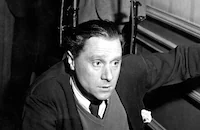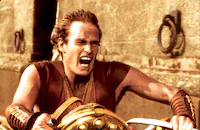The Agony and the Ecstasy

Brief Synopsis
Cast & Crew
Carol Reed
Charlton Heston
Rex Harrison
Diane Cilento
Harry Andrews
Alberto Lupo
Film Details
Technical Specs

Synopsis
In 1508, Pope Julius II, whose army is in constant warfare with neighboring states, has commissioned Michelangelo to create 40 statues for his tomb which is to be located in the new St. Peter's Basilica. The pope later asks Michelangelo to halt work on the tomb and decorate the ceiling of the Sistine Chapel, but the artist argues that he is not a painter. Nevertheless, he begins at the pope's insistence, but, discouraged by the mediocrity of his drawings, he destroys them and runs away to the marble quarries in the mountains. While there, he sees visions from Genesis and decides to use them for the theme of the ceiling paintings. He returns to Rome and begs the angered pope to allow him to continue his work. Against many obstacles, including an accidental fall and temporary blindness from the dripping paint, progress continues slowly with constant encouragement from Julius. Fearful that he may not return from battle, the pope orders the artist to let him view the unfinished work, but Michelangelo refuses. While Julius is on the battlefield, however, Michelangelo goes to him at the insistence of the Contessina de' Medici and apologizes for his action. When the wounded pope returns to Rome and is believed to be dying, Michelangelo visits him and persuades him to go to the Easter mass in the chapel. At the mass, Julius is awed by the magnificence of the mural; and Michelangelo requests to continue work on the sculptures for the pope's tomb.

Director

Carol Reed
Cast

Charlton Heston

Rex Harrison
Diane Cilento

Harry Andrews
Alberto Lupo

Adolfo Celi
Venantino Venantini
John Stacy
Fausto Tozzi
Maxine Audley
Tomas Milian
Crew
L. B. Abbott
Gus Agosti
Gus Agosti
Samuel E. Beetley
Casa D'arte-firenze
Alexander Courage
John De Cuir
Grazia De Rossi
Philip Dunne
Carlton W. Faulkner
Sam Gordon
Emil Kosa Jr.
Alex North
Vittorio Nino Novarese
R. Peruzzi
Piero Portalupi
Franco Potenza
Carol Reed
Leon Shamroy
Dario Simoni
Jack Martin Smith
Robert D. Webb
Douglas O. Williams

Videos
Movie Clip



Hosted Intro



Film Details
Technical Specs

Award Nominations
Best Art Direction
Best Cinematography
Best Costume Design
Best Score
Best Sound
Articles
The Agony and the Ecstasy
Carol Reed's stature had fallen some since the days of The Third Man (1949); most recently, he had had a disastrous experience shooting Mutiny on the Bounty (1962) with the unpredictable Marlon Brando. Heston recalled that the enthusiasm he felt for Reed was not immediately shared with others, but wrote in his diary, "We have a chance for a superior film with (Reed); he confers class on the whole project." Reed viewed the film as "a study of a genius, not a hero in the conventional sense," and added, "What interests me most is that Michelangelo was a man tormented by self-criticism, anxious about the work still left to do, who thought of his art as an act of self-confession." Charlton Heston, who had been intrigued by Philip Dunne's script even before any studio had signed on to produce it, found Michelangelo an elusive character. The actor not only spent time at the quarries where he had worked, but also climbed a scaffold to view the famous ceiling close up to ruminate on what had driven the artist's perfectionism.
Heston was also particularly sensitive about his physical portrayal of the artist. He felt that he had been taken to task by some critics of his previous work for looking the same in all of his previous films. In his biography In the Arena, he recalled that although he had based his makeup on portraits of the artist, "[Zanuck] didn't like my beard, or the way I'd twisted my nose... (and) he was especially distressed with the headcloth I wore." Exclaimed a frustrated Zanuck, "... You look like Othello, or some damn thing, for God's sake!" Heston and the director ignored these concerns and the makeup job remained. At least one critic, in Variety, later noted that Heston had "effectively submerged" his recognizable face with a beard and the "austere garb."
If Heston was obsessed with finding the man behind the story, Rex Harrison, who played Pope Julius II, was a little less concerned with historical accuracy. Harrison refused to wear the papal crown or don facial hair - an odd demand given that this particular Pope was well known as the first in centuries to have a beard and mustache. Harrison even admitted in his autobiography Rex that he had lifts placed in his shoes to bring him up to Heston's 6-foot-3 height. "I eyed Heston and congratulated myself that at least he no longer towered above me. As the film went on, however, it seemed to me that he was growing. Eyeball to eyeball he was once more a couple of inches taller than I. I looked down at his feet - not a sign of lifts! He must have grown through sheer tenacity. Neither of us made any comment, nor did our wardrobe men - it was a very funny, silent contest." A cordial but slightly strained relationship continued between the two actors and Harrison even admitted to making himself believe that "the picture was about Pope Julius rather than about Michelangelo." As for Heston, he compared his co-star to a racehorse that would appear "snorting, rearing, kicking at the starting gate" and who "picked petulantly at small points, for indiscernible reasons" like the ivory pointer that Julius had in his study. "What am I to do with this silly stick, for God's sake?" Harrison would ask. "In the end, of course, he broke it across my back," Heston said, "as the script indicated, as the real Julius had done to the real Michelangelo, and indeed as Rex knew perfectly well all along."
The tug of war between Michelangelo and the Pope over the completion the Sistine Chapel, a job that took four years and endless revisions, seemed to be replicated on the set between the lighting cameraman, Leon Shamroy and the rest of the production crew. Heston recorded in his journal that Shamroy was spending two thirds of each day lighting the set. Technical superiority certainly was evident in the finished product - reflected not only in the Academy Award nomination for cinematography, art direction and sound, but also by the astonishing replica of the Sistine Chapel built at Cinecitta, Dino De Laurentiis' Roman studios.
This proved to be an attraction unto itself. Although the Vatican was unusually generous in offering the actual site for shooting, technical requirements and the difficulty of ensuring that nothing would be damaged, made use of the actual chapel an impossibility. The decision was made to build a replica to scale. Studio technicians fussed over methods to reproduce the famous fresco, finally settling on photographing the original work and blowing up the photos to cover the ceiling in the "new" chapel. Interestingly, after the colors were brightened and cracks "filled in" by the set decorators, the facsimile ceiling presaged the results of the actual restoration of the chapel in the mid 1980's. Other locations for The Agony and the Ecstasy included the stone quarry in the village of Carrara where Michelangelo found the marble for his sculpture of Moses for the tomb of Pope Julius.
Heston later fondly recalled the reception the film received at a sneak preview in Minneapolis, writing, "I've been involved in some enormously successful films, but The Agony and the Ecstasy had far and away the best sneak preview response of any film I've ever been in...." Describing the standing ovation and loud shouts of applause, he was baffled by the modest box office that followed. As for Irving Stone's lament that Michelangelo's true artistic obsession had been overlooked, he was pleased to find that the feature film inspired the film's art director to produce a short documentary entitled, The Artist Who Did Not Want to Paint (1965).
Producer/Director: Carol Reed
Screenplay: Philip Dunne, based on the novel by Irving Stone
Art Designer: Jack Martin Smith
Costume Designer: Vittorio Nino Novarese
Cinematography: Leon Shamroy
Editing: Samuel E. Beetley
Music: Alex North
Cast: Charlton Heston (Michelangelo), Rex Harrison (Pope Julius II), Diane Cilento (Contessina de Medici), Harry Andrews (Bramante), Alberto Lupo (Duke of Urbino), Adolfo Celi (Giovanni de Medici), Venantino Venantini (Paris de Grassis), Tomas Milian (Raphael).
C-124m. Letterboxed.
by Genevieve McGillicuddy

The Agony and the Ecstasy
Quotes
When will you make an end?- Pope Julius II
When I'm finished!- Michelangelo
Your question insults us both!- Contessina de Medici
You dare to dicker with your pontiff?- Pope Julius II
Trivia
Notes
Copyright length: 136 min. Filmed in Rome and other places in Italy.

Miscellaneous Notes
Voted Best Supporting Actor (Andrews, also for his work in "The Hill") and One of the Year's Ten Best Films by the 1965 National Board of Review.
Released in United States Fall October 7, 1965
Todd-AO
Released in United States Fall October 7, 1965













